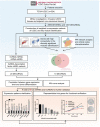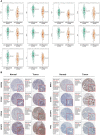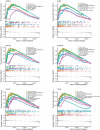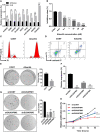Identification of Hub Genes Correlated With Poor Prognosis for Patients With Uterine Corpus Endometrial Carcinoma by Integrated Bioinformatics Analysis and Experimental Validation
- PMID: 34868993
- PMCID: PMC8639584
- DOI: 10.3389/fonc.2021.766947
Identification of Hub Genes Correlated With Poor Prognosis for Patients With Uterine Corpus Endometrial Carcinoma by Integrated Bioinformatics Analysis and Experimental Validation
Abstract
Uterine Corpus Endometrial Carcinoma (UCEC) is one of the most common malignancies of the female genital tract and there remains a major public health problem. Although significant progress has been made in explaining the progression of UCEC, it is still warranted that molecular mechanisms underlying the tumorigenesis of UCEC are to be elucidated. The aim of the current study was to investigate key modules and hub genes related to UCEC pathogenesis, and to explore potential biomarkers and therapeutic targets for UCEC. The RNA-seq dataset and corresponding clinical information for UCEC patients were obtained from the Cancer Genome Atlas (TCGA) database. Differentially expressed genes (DEGs) were screened between 23 paired UCEC tissues and adjacent non-cancerous tissues. Subsequently, the co-expression network of DEGs was determined via weighted gene co-expression network analysis (WGCNA). The Blue and Brown modules were identified to be significantly positively associated with neoplasm histologic grade. The highly connected genes of the two modules were then investigated as potential key factors related to tumor differentiation. Additionally, a protein-protein interaction (PPI) network for all genes in the two modules was constructed to obtain key modules and nodes. 10 genes were identified by both WGCNA and PPI analyses, and it was shown by Kaplan-Meier curve analysis that 6 out of the 10 genes were significantly negatively related to the 5-year overall survival (OS) in patients (AURKA, BUB1, CDCA8, DLGAP5, KIF2C, TPX2). Besides, according to the DEGs from the two modules, lncRNA-miRNA-mRNA and lncRNA-TF-mRNA networks were constructed to explore the molecular mechanism of UCEC-related lncRNAs. 3 lncRNAs were identified as being significantly negatively related to the 5-year OS (AC015849.16, DUXAP8 and DGCR5), with higher expression in UCEC tissues compared to non-tumor tissues. Finally, quantitative Real-time PCR was applied to validate the expression patterns of hub genes. Cell proliferation and colony formation assays, as well as cell cycle distribution and apoptosis analysis, were performed to test the effects of representative hub genes. Altogether, this study not only promotes our understanding of the molecular mechanisms for the pathogenesis of UCEC but also identifies several promising biomarkers in UCEC development, providing potential therapeutic targets for UCEC.
Keywords: hub gene; protein-protein interaction network; tumor differentiation; uterine corpus endometrial carcinoma; weighted gene co-expression network analysis.
Copyright © 2021 Yuan, Chen, Cai, He, Li and Zhao.
Conflict of interest statement
The authors declare that the research was conducted in the absence of any commercial or financial relationships that could be construed as a potential conflict of interest.
Figures










Similar articles
-
Identification and validation of hub genes in uterine corpus endometrioid carcinoma: An observational study from TCGA and GEO.Medicine (Baltimore). 2025 May 2;104(18):e42338. doi: 10.1097/MD.0000000000042338. Medicine (Baltimore). 2025. PMID: 40324248 Free PMC article.
-
Identification of novel key genes associated with uterine corpus endometrial carcinoma progression and prognosis.Ann Transl Med. 2023 Jan 31;11(2):100. doi: 10.21037/atm-22-6461. Ann Transl Med. 2023. PMID: 36819577 Free PMC article.
-
Exploring Prognosis-Associated Biomarkers of Estrogen-Independent Uterine Corpus Endometrial Carcinoma by Bioinformatics Analysis.Int J Gen Med. 2021 Nov 30;14:9067-9081. doi: 10.2147/IJGM.S341345. eCollection 2021. Int J Gen Med. 2021. PMID: 34876842 Free PMC article.
-
Comprehensive bioinformatic analyses of lncRNA-mediated ceRNA network for uterine corpus endometrial carcinoma.Transl Cancer Res. 2022 Jul;11(7):1994-2012. doi: 10.21037/tcr-22-249. Transl Cancer Res. 2022. PMID: 35966302 Free PMC article.
-
LINC01589 serves as a potential tumor-suppressor and immune-related biomarker in endometrial cancer: A review.Medicine (Baltimore). 2023 Apr 14;102(15):e33536. doi: 10.1097/MD.0000000000033536. Medicine (Baltimore). 2023. PMID: 37058060 Free PMC article. Review.
Cited by
-
Identification of hub genes and pathways in Uterine corpus endometrial carcinoma (UCEC): A comprehensive in silico study.Biochem Biophys Rep. 2024 Nov 1;40:101860. doi: 10.1016/j.bbrep.2024.101860. eCollection 2024 Dec. Biochem Biophys Rep. 2024. PMID: 39552710 Free PMC article.
-
Deciphering DNA repair gene mutational landscape in uterine corpus endometrial carcinoma patients using next generation sequencing.Am J Cancer Res. 2024 Jan 15;14(1):210-226. doi: 10.62347/DJVS8353. eCollection 2024. Am J Cancer Res. 2024. PMID: 38323278 Free PMC article.
-
Identification of immune-related gene signature for predicting prognosis in uterine corpus endometrial carcinoma.Sci Rep. 2023 Jun 7;13(1):9255. doi: 10.1038/s41598-023-35655-x. Sci Rep. 2023. PMID: 37286702 Free PMC article.
-
KIF2C/MCAK a prognostic biomarker and its oncogenic potential in malignant progression, and prognosis of cancer patients: a systematic review and meta-analysis as biomarker.Crit Rev Clin Lab Sci. 2024 Sep;61(6):404-434. doi: 10.1080/10408363.2024.2309933. Epub 2024 Feb 12. Crit Rev Clin Lab Sci. 2024. PMID: 38344808 Free PMC article.
-
Identification and validation of hub genes in uterine corpus endometrioid carcinoma: An observational study from TCGA and GEO.Medicine (Baltimore). 2025 May 2;104(18):e42338. doi: 10.1097/MD.0000000000042338. Medicine (Baltimore). 2025. PMID: 40324248 Free PMC article.
References
LinkOut - more resources
Full Text Sources
Research Materials
Miscellaneous

